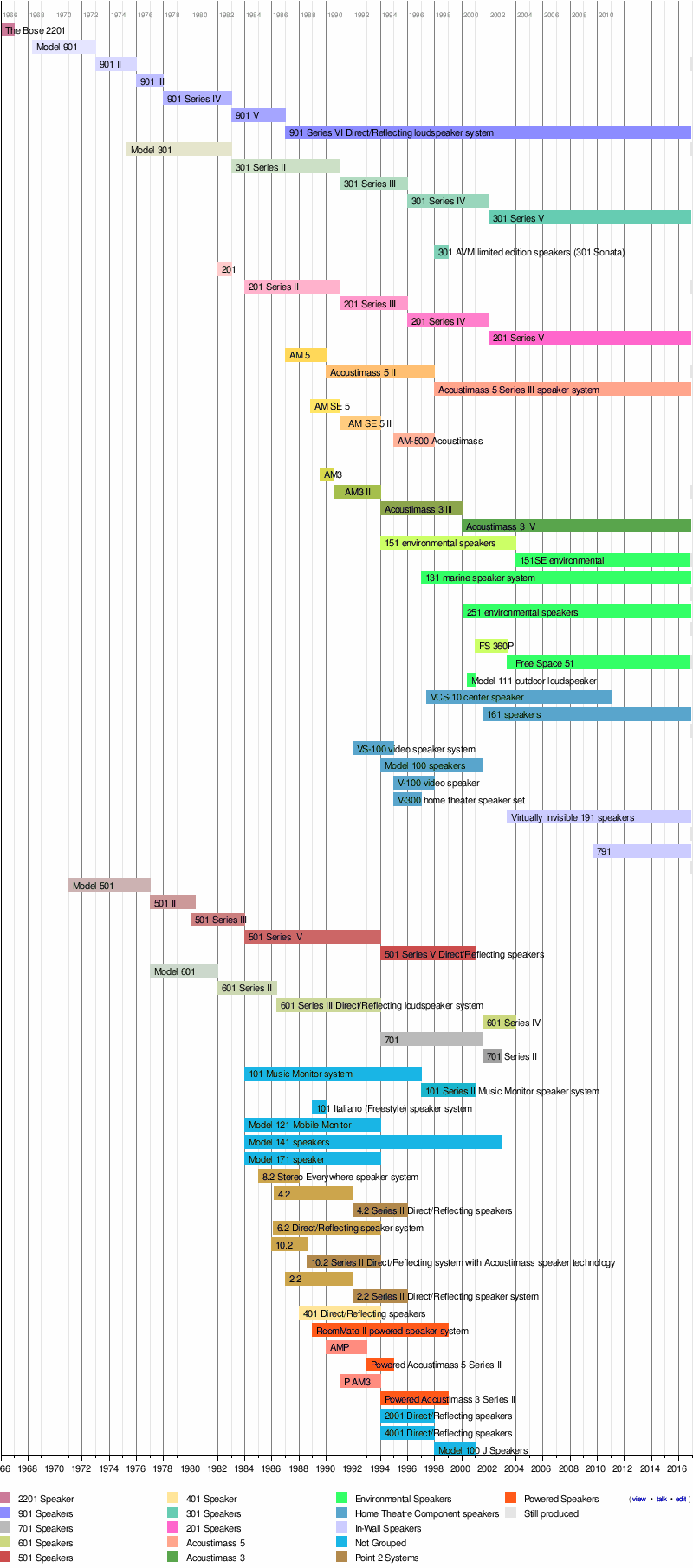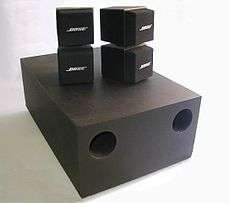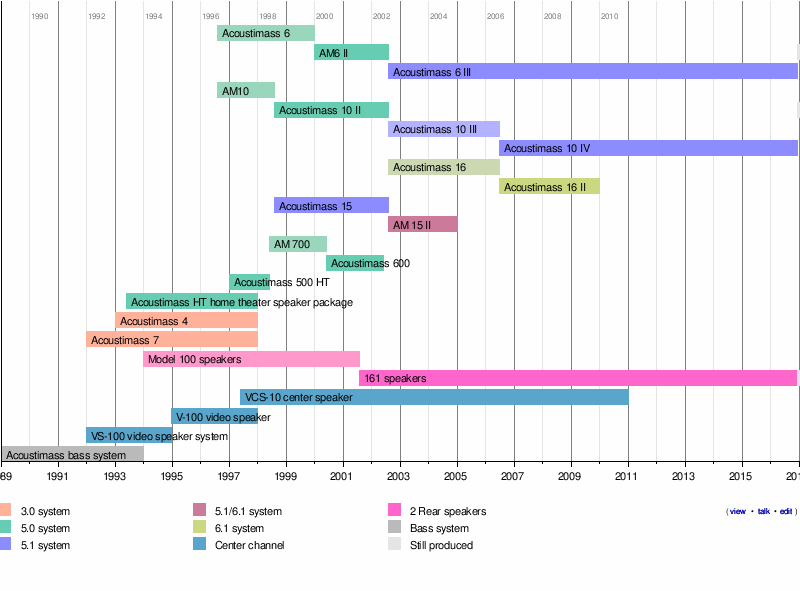Bose speaker packages
Bose has been selling stereo speaker packages since 1966 and surround sound speaker packages since 1992. Since that time the company has produced a range of stereo and surround sound speakers to be powered by a receiver or amplifier.
Timeline of Bose stereo speakers

("AM" = Acoustimass; "AMP" = Acoustimass powered; "P AM3" = Powered Acoustimass 3 & "FS 360P" = FreeSpace 360P)
Sources: Bose owners guides[1]
Stereo speaker packages

Bose has been a manufacturer of stereo speakers since the late 1960s. In the current range, the 201, 301 and 901 systems use the unique design where most of the drivers face away from the listener. The Acoustmass 3, Acoustimass 5, 191, 791 and 161 systems use a conventional design, where the drivers face the listener.[2]
2201
Bose's first loudspeaker product, the model 2201, dispersed 22 small mid-range speakers over an eighth of a sphere. It was designed to be located in the corner of a room, using reflections off the walls to attempt to increase the apparent size of the room.[3] Electronic equalization (with user controls labelled "Bass", "Mid-bass" and "Treble"[4]) was used to flatten the frequency response of this system.[5][6][7][8] The results of listening tests were disappointing[9] (a later Bose publication presents theories regarding these results[10]), which led to Bose conducting further research and, ultimately, developing the 901 speaker system.
901
The 901 Speaker System is a hallmark for Bose[5][7] and was released in 1968. The speakers were a huge commercial success for Bose, contributing significantly to Bose's rapid growth throughout the 1970s.[5]
Design
In researching a successor to the 2201, Bose proposed that a dominance of reflected sound arriving is important in emulating live performances. This led to a speaker design in which eight identical mid-range drivers were aimed at the wall behind the speaker while the ninth driver was aimed toward the listener. The purpose of this design was to achieve a dominance of reflected over direct sound in home listening spaces. The pentagonal design used in the Model 901 was (and remains) unconventional compared with most systems where the mid-range and high-frequency speakers directly face the listener.
An electronic equalizer was implemented by Bose to modify the speakers frequency response.[5][6][7][8] Bose's marketing term for control of acoustics within the cabinet (a design process which is undertaken for all brands of loudspeakers) is termed "Acoustic Matrix Enclosure".
Review
Bose's flagship 901 speaker system was criticized by Stereophile magazine in 1979.[11] In a review of the 901 system, stating that in the magazine's opinion, the system was unexceptional and unlikely to appeal to perfectionists with a developed taste in precise imaging, detail, and timbre; and that these shortcomings were an excessive price to pay for the improvement in impact and ambiance generated by the large proportion of reflected sound (to on-axis sound). However, the author also stated that the system produced a more realistic resemblance of natural ambiance than any other speaker system.
Acoustimass
The Acoustimass 3 and Acoustimass 5 are stereo speaker systems. The Acoustimass 3 is a single cube 2.1 speaker system with a bass module that contains one 5.25" speaker. The Acoustimass 5 is a double cube 2.1 speaker system with a bass module that contains two 5.25" speakers.
Timeline of Bose surround sound speakers

Sources: Bose owners guides[12]
Surround sound speaker packages
The Bose Acoustimass Home Entertainment Systems are Bose's line of surround sound speakers. The original Acoustimass speaker set was introduced in 1987, as the Bose Acoustimass 5 Series I. This was a stereo speaker system. It had two direct-reflecting speakers that connected to a passive bass then to the receiver. In 1995 Bose released a surround sound version called the Acoustimass 6 & 10. It wasn't until 2001 that a powered bass module was introduced allowing for true 5.1. The speakers are connected directly to the bass module, which is connected directly to the receiver.
Systems
- The Acoustimass 6 is a single cube 5.1 speaker system. The Bass module contains one 5.25" speaker.
- The Acoustimass 10 is a double cube 5.1 speaker system. The Bass module contains two 5.25" speakers.
- The Acoustimass 15 is a double cube 5.1 speaker system, it has the option to add on another speaker making it into a 6.1 system. The Bass module contains three 5.25" speakers. This model was replaced in 2004 by the Acoustimass 16.
- The Acoustimass 16 is a double cube 6.1 speaker system. The Bass module contains three 5.25" speakers.
See also
External links
- Acoustimass 6 series III review
- Acoustimass 10 series IV review
- Acoustimass 16 series I review
- Stereophile review of the Bose 901
- Bose.com 901 information
References
- ↑ Bose Owners Guides. List of stereo speakers powered by a receiver, does not include combination packages, Retrieved November 11, 2009.
- ↑ http://www.bose.com/controller?url=/shop_online/speakers/stereo_speakers/index.jsp
- ↑ Direct/Reflecting speaker technology – the challenge
- ↑ http://products.bose.com/pdf/customer_service/owners/og_901.pdf
- 1 2 3 4 Company History: Bose Corporation
- 1 2 Bose 901 loudspeaker By J. Gordon Holt November, 1979 Stereophile
- 1 2 3 Bose 901
- 1 2 Sound all around: the new multi-directional speakers
- ↑ "Archived copy". Archived from the original on 2012-12-02. Retrieved 2012-10-21.
- ↑ Bose Panaray MA12 technical papers Archived February 29, 2012, at the Wayback Machine.
- ↑ Stereophile Review
- ↑ Bose Owners Guides. This is a list of Bose speaker systems designed for surround sound receivers, does not include combination packages, Retrieved August 24, 2010.